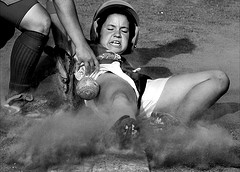Has anyone noticed that the art of sliding has been lost in the game?
I’ve witnessed these at all levels–from international competition to the collegiate game to my daughter’s 12U competitive travel team.

It’s not uncommon to see a base runner slide into base sitting up, reaching her hand to the base as she slides by. This is really the worse slide because:
- It delays the base runner getting into the bag
- The defensive player has more time to catch the ball and tag the baserunner out
- The baserunner becomes an easier target, since the upper shoulder is in easy reach of the fielder.
It happens a lot at home, but I see it more often at second base. The player thinks she is sliding away from the base when all she is doing is giving the fielder more time to make a play.
It’s really the exact opposite of what the baserunner should be doing when she slides. The basic slide–the straight-in feet-first slide–is much better because the player gets to the bag quickly and slides hard with authority. If there’s any kind of bobble, the slider can dislodge the ball. It also makes it much more difficult for the fielder to catch the ball and tag the player, since the slider is in the middle of the action.
If the base runner is to the side of the bag, there is no disruption.
Whenever possible, the slider should put herself between the fielder who is throwing the ball and the fielder who is catching the ball. When sliding into home, for example, the base runner can put herself between the catcher and throws from the shortstop, left field or third base. The baserunner should always take the inside line.
Another sliding technique is the straight-in head first slide. This is the fastest option, as the player grabs the bag to avoid a tag. It doesn’t quite disrupt the fielder as much as the hard feet-first slide, but it is the quickest way to the bag.
A baserunner should be taught to read the situation. She should be able to answer these questions:
- Where is the defensive player receiving the ball?
- Where is the ball coming from?
- Where is the ball?
She always needs to be aware of the location of the ball and where she is in relation to the base and the defensive player. Then, she can pick the slide to use for each particular situation.
For example, a hook slide should be used if she needs to slide away from the bag. This is a skill that has become lost on the younger players of today, but one that if mastered, can give a baserunner an advantage.
Sliding is like any other skill–it has to be practiced. Teach sliding from the ground up, starting with the players laying on the ground in position. Then break it down, just like you do when you teach any other skill. YOU MUST SLIDE IN PRACTICE IF YOU EXPECT TO SLIDE IN A GAME!
At our practices, we use baserunners all the time–when we’re hitting or fielding, it gives the baserunners an opportunity to read situations and select the appropriate slide, along with practicing their technique.